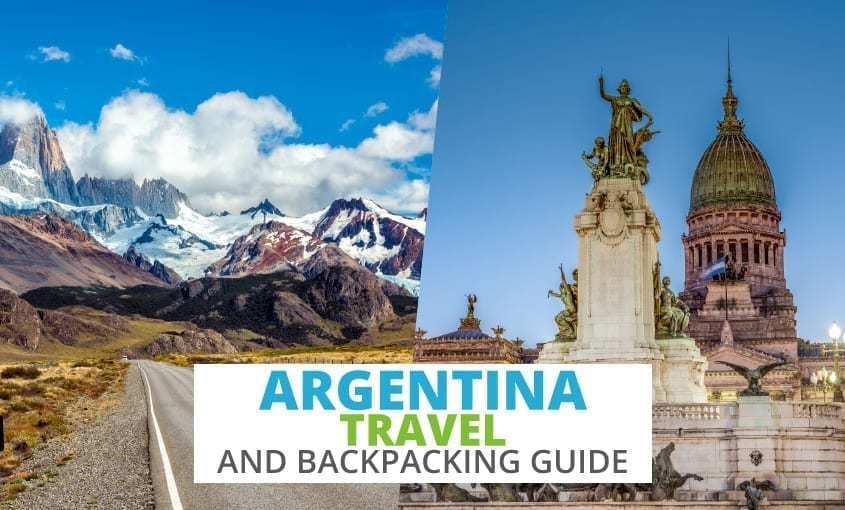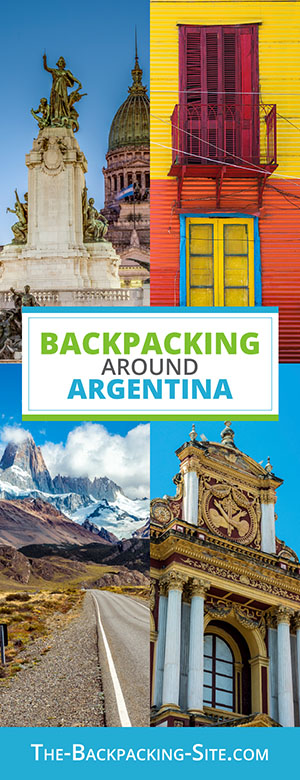
Backpacking Argentina
Looking for important travel information while backpacking in Argentina? Here you will find information on working in Argentina, entry visas, Argentinian hostels, and much more.
Table of Contents
- Facts About Argentina
- Things to do in Argentina
- Entry Visa Requirements for Argentina
- Foreigner Work Permits and Backpacker Jobs in Argentina
- Argentina Hostels
Facts About Argentina
Argentina is a country with something of a dual identity, being at once a pivotal part of South American culture, and yet also bearing a close resemblance to Europe. It is also remarkable for its size; at 2,766,890 km, Argentina is second only to Brazil and ranked eighth largest country in the world. Indeed, it is even larger if you give credence to their claims on the Falkland Islands and a significant portion of Antarctica.
The first inhabitants of Argentina settled in the south around 11000BC, but the first major recorded event was the prolonged assault on the northwest region by the Inca Empire in 1480, the success of which fragmented the territory into disparate cultures.
European intervention followed soon after, with Amerigo Vespucci sighting the territory on his 1502 voyage and further Spanish exploration climaxing with the establishment of the Buenos Aires Colony in 1580 as part of controlled Peru. The colony prospered in subsequent centuries economically, but the independence movement progressed proportionately. The issue was concluded in 1816 after the campaigns of General San Jose de San Martin in the region and Napoleon’s overthrow of Spain’s Ferdinand VII.
Expanding from Buenos Aires, the modern Argentina, named ‘the Land of Silver’ by Spanish explorers due to the rich region in Potos, developed rapidly courtesy of agriculture and foreign investment. One of the richest countries in the world by the early 20th century, political turmoil thereafter between groups represented by Juan Peron in the 1940s and the conservative military damaged the country immeasurably. These economic problems persisted for the rest of the century and were only assuaged during the 2000s with economic growth and stability. As such, it truly is the perfect time to visit the country.
- Language – Spanish
- Population – 39,921,833 (2006 estimate)
- Currency – Peso (the $ is used)
- Time zone – GMT -3
- Phone code – +54
Climate in Argentina
When deciding the best time to visit Argentina, the weather certainly plays a role. Argentina is generally a temperate climate, but with two extremes. The north is closer to a tropical climate, whereas the south is polar. This is born out in the record temperatures of 49 degrees in Cordoba in 1920 and -39 degrees in San Juan in 1972. Central Argentina is incredibly erratic but tends to more closely approximate the north.
Things to do in Argentina
Buenos Aires
Buenos Aires is still referred to as the ‘Paris of the Southern Hemisphere’ and attracts some 5.25 million tourists per year thanks to its thriving culture. The national Tango dance centres in the capital offer a great way to get involved in the lifestyle – head for the ‘Milongas’ to give it a try.
If you fancy taking it a bit further, why not go to a studio for lessons, try the Avenue Corrientes, or check out the shows in Dorrego Square on Sundays. The nightlife doesn’t solely revolve around the Tango though. You can find a number of great nightclubs, Irish pubs and bars across the city and, in particular, the areas of Recoleta, San Telmo and Palermo Viejo.
Buenos Aires is home to an array of fantastic sights as well. Chief among these is the 67-metre-tall Obelisk of Buenos Aires, completed in 1936 to celebrate the 400th anniversary of the city and a true symbol of the capital.
Other notable landmarks include the world-famous Teatro Colon, opened in 1908, the Casa Rosada (Pink House), situated in the fantastic Plaza de Mayo and home to the executive branch of the Argentinean government, and the 18th century neo-classical Buenos Aires Metropolitan Cathedral. If that’s not enough, there are plenty of great galleries and museums like the Museo Nacional de Bellas Artes, the Evita Museum and the Museum of Latin American Art of Buenos Aires (Malba).
Cordoba
However, if you want to see the real Argentina, don’t confine yourself to the capital. The country is packed with great cities, each with phenomenal sights and unique culture. Cordoba, for example, is home to the beautiful Jesuit Block and Estancias, a complex of beautifully preserved 17th and 18th-century buildings including the Universidad Nacional which is classified a UNESCO World Heritage site. You’ll also find the imposing 16th century Gothic Cordoba Cathedral and over ten galleries and museums to choose from like the Museo Municipal de Bellas Artes ‘Dr. Genaro Perez’.
Iguazu Falls
Indeed, most of Argentina’s best locations can be found outside of Buenos Aires. Nature lovers will be captivated by the host of national parks, which include the World Heritage classified Iguazu National Park in the Misiones province, including endangered species like the jaguar and home to the incredible Iguazu Falls, and Los Glaciares National Park in Santa Cruz. No less impressive is the Cueva de las Manos (Cave of the Hands), also in Santa Cruz, highlighted by cave paintings some 9000 years old and containing handprints.
Mar del Plata
Situated on the coast of South America, there are naturally a number of resort towns where you can relax on the sand with the sun for company. The largest of these is Mar del Plata, which attracts tourists en masse every year.
Unique Activities in Argentina
Since popular places in Argentina can get crowded during tourist season, it is wise to reserve tickets and activities ahead of time. GetYourGuide sells entrance tickets to museums and landmarks at face value so you can avoid the lines and save that precious time for more exploring.
Viator is another popular travel website that helps you book things to do in Argentina. They work directly with local tour operators in Argentina, so you won’t have to scour the internet or roam around town trying to find the best deal.
If you know your schedule ahead of time, a great insider tip is to buy tickets for major tourist attractions ahead of time. Tiqets has entrance tickets and skip-the-line passes for major attractions in Argentina, which can be a worthwhile cost during peak tourist season.
How to Get Cheap Flights to Argentina
In order to find the best flights to Argentina we recommend using a few well-known flight comparison search engines. These websites offer powerful search options, like entering flexible dates and airports in order to find the cheapest flight to Argentina.
Our go-to flight search engine is Skyscanner, which we love for its extremely flexible search options. Our favourite way to get travel inspiration is their “Everywhere” feature. Simply enter “Everywhere” as a destination, and it will then list all available flights from your departure city in order of price. This also works when entering the entire country of Argentina as your destination. Skyscanner will search all possible airports in the country in order to find the cheapest option.
Kiwi is another new favourite flight search engine among savvy travelers. Kiwi works by combining flights from different carriers in order to get the best deal. Also, if there is a better ground or ferry option for the route you’re searching, Kiwi will include that in the search results. On average, we have found the cheapest flights to Argentina with them compared to the other websites out there. How to Travel Around Argentina
How to Travel Around Argentina on a Budget
Once in Argentina, city-to-city travel is typically achieved by using long distance buses. The Panamerican National Route 9, for example, takes you through Buenos Aires, Rosario and Cordoba. As provincial capitals all have their own airport and operate regular flights on a daily basis, an alternative for those with a bit of spare cash is air travel.
The train network in Argentina is limited but extremely cheap, making it a decent budget option. A great tourist voyage is the ‘Train of the Clouds’ in the northwest province of Salta, which passes a number of smaller towns on its way to the border with Chile and takes you to extreme altitudes.
Driving in Argentina
You may also want the flexibility to stop in smaller towns between the major cities. If you decide you want to rent a car in Argentina, you can use DiscoverCars to compare offers from the major car rental agencies in the region.
Backpacking Tours in Argentina
Though part of the fun of backpacking Argentina is exploring on your own, there are situations, especially when venturing off the tourist trail, when it does make sense to go with a guide or a small group.
The most popular option for social travel in Argentina is Contiki tours. Contiki trips offer more than just transportation, they are organized social group travel for travelers aged 18-35. Whether you’re traveling by yourself or going with a group of friends, Contiki tours are perfect for people looking to have a blast, meet new friends, and form lifelong memories. They offer tours that travel primarily in Argentina or longer tours that cover other nearby places.
G Adventures is another great option for organized travel, but with a smaller group. It’s a great choice for anyone backpacking Argentina alone who would like to meet up with like-minded travellers. It’s also a practical option for exploring places where you need an experienced guide, like a long hiking adventure or visiting a place well off the beaten path. You can choose from different styles of small group tours like active, wellness, hiking trips, 18-30somethings, and more. Their most popular trips in Argentina are their 14-day End of the Earth Patagonia tour including Argentina and Chile, and their 19-day Patagonia Hiking trek.
Health and Safety in Argentina
The quality of health care is good in Buenos Aires, but varies elsewhere. Unfortunately, the cost of treatment in Argentinean hospitals is very high and cash payment is expected immediately. Recommended for tourists are the British and German hospitals scattered across major cities.
Before travelling, jabs for Hepatitis A and B, malaria, rabies, typhoid and yellow fever are recommended. However, many travellers ignore this advice and find their only nemesis is diarrhoea.
The water in Argentina is generally safe for drinking, but be wary outside of Buenos Aires.
As with travel to all other countries abroad, it is vital that you get travel insurance before you leave for Argentina. Even for short trips, our go-to travel insurance provider is World Nomads, which is also recommended by Lonely Planet, HostelWorld, and other major travel companies.
Entry visa requirements for Argentina
A passport is the only requisite for citizens of the US and EU member nations for stays up to 90 days. This can be extended once for a further 90 days by the Immigration Department.
Visa requirements for Argentina can vary widely depending on your country of origin and can change over time. To avoid any unpleasant surprises, be sure to check the latest visa requirements while you’re still planning your trip.
Foreigner work permits and backpacker jobs in Argentina
If you are a Spanish speaker, you can easily get work translating or teaching English. Call centres and bar work are also accessible and popular options. The average wage is on the rise and currently stands at around AR $550, with the minimum wage at $450. Nevertheless, it is important to remember that unemployment in Argentina is relatively high and, if you do not speak some Spanish, most avenues will be blocked.
Opportunities to volunteer in Argentina are far easier to come by, whether in the community, education, for the environment or providing medical assistance. Check out the options at Transitions Abroad for further details of what’s on offer.
Argentina Hostels and Budget Accommodation

Buenos Aires is a great city for backpackers and budget travellers due to its array of hostels, numbering over 50 and including B&B in Constitucion and Gardenhouse Hotel. However, be sure to shop around, particularly in the San Telmo area, where prices are generally just 20-30 pesos a night.
If you’d prefer a mid-range hotel though, expect to pay around $30 a night. Prices at the top end are typically $70. That said, with both hotels and hostels, if you look outside of Buenos Aires, you should find even better prices.
We have had good experiences finding hostels in Argentina on HostelWorld. They have the largest inventory of hostels worldwide, and with over 10 million reviews and ratings from other travellers, you know exactly what to expect.
Another good way to find accommodation in Argentina is by checking booking.com. You’ll find hotels, homestays, hostels, and other unique accommodations. They have the most reviews and advanced filtering of any accommodation-booking site, so you’ll be sure to find a great place in your budget. Many of the places on booking.com also offer free cancellation, which takes the pressure off the planning phase of your trip to Argentina.
If you are backpacking with another travel companion, we highly recommend booking a rental via VRBO. With a vacation rental in Argentina, you’ll have more space, your own kitchen, and you’ll get a better feel for how the locals live. Plus, the cost of a vacation rental can be split among your group, oftentimes making it cheaper than doing individual hotel rooms.
If you’re looking to save even more money while backpacking in Argentina, there are plenty of creative ways to get free accommodation in exchange for work. For example, one of our favorite ways to stay in amazing locations for free is by signing up as a petsitter with Trusted Housesitters. The site connects responsible animal lovers with petsitting opportunities in Argentina and all over the world. It’s a win-win for both sides – travellers can stay in amazing locations for free, and homeowners can rest easy knowing that someone is watching over their place.
And lastly, CouchSurfing is a great community that connects travellers with local hosts in Argentina. You can stay for free with verified hosts, who will usually take some time to show you around the local spots.
Useful links for Backpacking in Argentina
- GAdventures – guided small group tours in Argentina, great for solo travellers or for those interested in a more adventurous trip which would require a guide
- DiscoverCars – The world’s leading rental car search engine to rent a car in Argentina
- Kiwi and Skyscanner – Flight comparison search engines to find the cheapest flights to Argentina and within the country
- GetYourGuide and Viator – a collection of local tours and activities in Argentina. Also offers Skip the Line tickets for crowded attractions
- Tiqets – Website selling entrance tickets and skip the line tickets for major tourist attractions in Argentina
- HostelWorld – #1 hostel search website to find accommodation while backpacking Argentina. Thousands of hostels and millions of reviews from fellow travellers
- Booking.com – commonly used booking site for accommodation in Argentina. Find hostels, hotels, and other unique accommodations in Argentina with advanced filtering and millions of reviews
- World Nomads Travel Insurance – Comprehensive travel insurance for long and short trips when backpacking Argentina
There you have it, the ultimate Argentina backpacking guide. We hope you have found all the information you need for backpacking around Argentina.
Next up:
Liked this article? Share it with others who might be after the same information!

